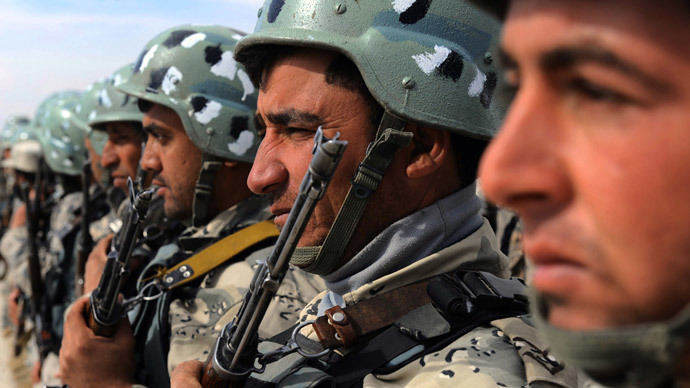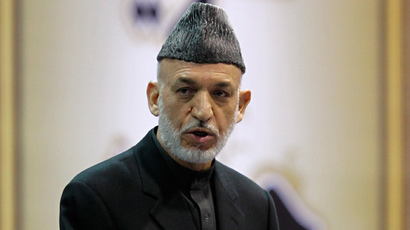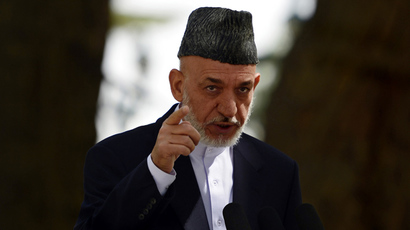Afghanistan bleeding US taxpayers, corruption the culprit

Rampant corruption in Afghanistan could spell disaster for America’s reconstruction efforts after more than a decade of war in the Central Asian country, according to the Special Inspector General for Afghanistan Reconstruction.
As Washington attempts to make a graceful exit from Afghanistan,
the scene of its longest and most expensive war in its history,
the basic lack of oversight over key reconstruction projects has
led to corruption on a massive scale.
It was even established that the United States, together with its
allies, were paying ‘ghost workers’ in the national police force
an unknown sum that was a "very significant amount of US
taxpayer money," said Special Inspector General for
Afghanistan Reconstruction (SIGAR) John F. Sopko.
Now many in Washington are scratching their heads, wondering how
the $102 billion earmarked for Afghan reconstruction and security
was wasted.
Soko points to “massive military and aid spending overwhelmed
the Afghan government's ability to absorb the assistance”
and “coupled with weak oversight, created opportunities for
corruption.”
“We opened the spigots and let the cash flow.”
"We don't even know what we spend and where we spend it 12
years into this," Sopko admitted. "That's the
frustrating thing."
Sopko ticked off a number of shocking truths about the state of
Afghanistan’s infrastructure, including newly-constructed schools
that were in "danger of collapsing," medical facilities
low on medicine and supplies, highways that were
"disintegrating faster than we can build them."
But the trail of waste doesn’t end there. Sopko warned that the
very future of Afghanistan was at risk of perishing if the United
States failed to reign in the real enemy of corruption.
“The costs in Afghanistan - both in lives lost and money
spent - have been enormous,” he said. “If we don't… get
serious about corruption right now, we are putting all of the
fragile gains that we have achieved in this - our longest war -
at risk of failure.
“If we get it right, we can create a model for future
contingencies and help the Afghan people build a country that
does not become another failed criminal state and a safe haven
for terrorists.”
However, many are questioning whether the United States can
continue to foot the bill for the Afghan military adventure, as
well as the cleanup and reconstruction.
Last year, Linda J. Bilmes, a Harvard professor, estimated in
a report that US wars in Afghanistan and Iraq
will cost taxpayers $4-$6 trillion (the research took into
account the medical rehabilitation of injured veterans, as well
as costly repairs to a military drained by more than a decade of
dual-front fighting).
“As a consequence of these wartime spending choices, the
United States will face constraints in funding investments in
personnel and diplomacy, research and development and new
military initiatives,” the report says. “The legacy of
decisions taken during the Iraq and Afghanistan wars will
dominate future federal budgets for decades to come.”
It should as no surprise that the Afghan people regularly
describe their government agencies as corrupt.
"In response to a number of surveys, Afghan citizens have
described the Afghan justice system and police force as
particularly corrupt," the inspector general said.
Last year, Afghanistan tied with Somalia and North Korea as
countries with the highest perceived levels of corruption among
177 states, according to Transparency International.
However, US foreign policy is also responsible for much of the
corruption, Sopko said, allowing “criminal networks involved
in everything from extrajudicial land seizures and extortion, to
narcotics trafficking and money laundering.”
Of all criminal activities in Afghanistan, however, none has
flourished as much as opium production, a grim harvest that was
altogether eliminated under Taliban rule.
The Afghanistan Opium Survey for 2013 showed that land used for
opium cultivation hit a historic high in 2013 of 516,000 acres -
a 36 percent increase from 2012. Today, 19 of the country’s 34
provinces are opium producers, which has led to a surge in the
number of heroin addicts across Europe, Central Asia and Russia.
“This has never been witnessed before in the history of
Afghanistan,” said Jean-Luc Lemahieu, the former head of the
Afghanistan office of the United Nations Office on Drugs and
Crime, as quoted by the New York Times.
Sopko said SIGAR would continue to investigate the allegations of
corruption now hampering not only the US military pullout, but
the hope for a brighter future for Afghans. He also pointed to
next month's presidential elections, which he said could herald
in a new leader to tackle the endemic corruption.
"All the major candidates say they want to combat
corruption," he said.













